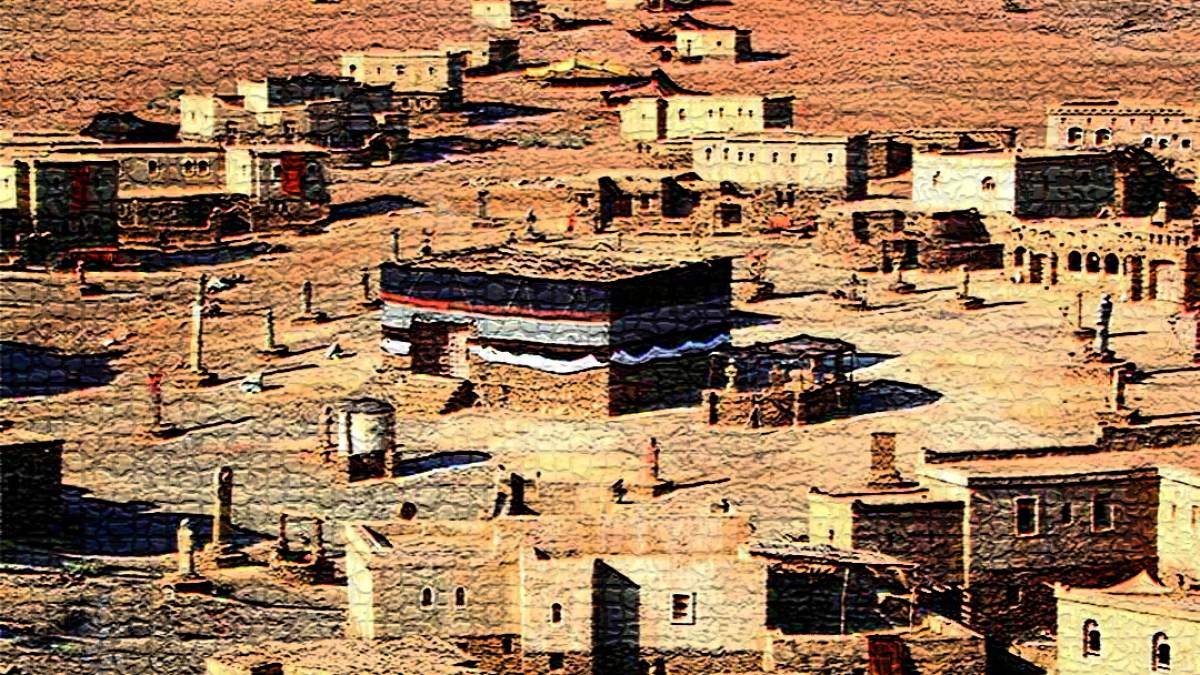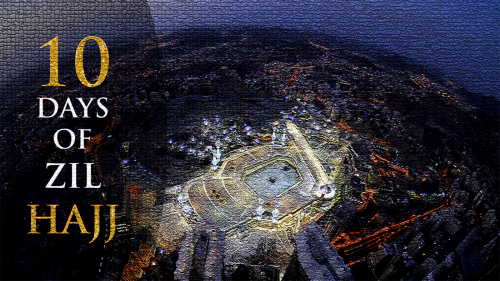How Two Jewish Rabbis Respected and Protected The Ka'bah

At the cross road of both identities, my theology is especially informed by Ibn Kathir’s Tafsir of Quran verse 44:37 which I believe is an amazing story that needs to be shared. The intertwined history of Jews and Arabs in Arabia is a very important study that has the potential of advancing reconciliation and understanding between Jews and Muslims.
Before I can explain Ibn Kathir’s account of the two rabbi who protected the Ka’bah, I have to relate something about the Jews in Arabia in the five centuries before the birth of Prophet Muhammad(PBUH).
The general picture of this period in pre-Islamic Arabia is one of tribal feuds and anarchy, dominated by what is termed “jahilliyah” in Arabic (culmination of ignorance, lawlessness, illiteracy and pagan cults). For generations before Mohammed’s “hijra” from Mecca to Medina in 622 CE, the societies and centralized states in Europe and the Middle East were weakened by incessant warfare between the Christian Byzantine and Zoroastrian Persian empires.
One key, but often forgotten, player in Arabia at that time was the kingdom of Himyar. Himyar which was established around the 2nd century CE, had become a regional power by the 4th century. Based in today’s Yemen, Himyar had conquered neighboring states, including the ancient kingdom of Sheba (whose queen met with Solomon according to Judeo-Christian-Islamic traditions).
In a recent article titled “What kind of Judaism in Arabia?” Christian Robin, a French epigraphist and historian says most scholars now agree that, around 380 CE, the elites of the kingdom of Himyar converted to Judaism. This claim is supported by his discoveries during a 2014 French-Saudi expedition studying rock inscriptions around Bir Hima- a site about 100 kilometers north of the city of Najran in southern Saudi Arabia. The expidition discovered what could be the oldest texts written in the Arabic alphabet. At least two of the early Arabic petroglyphs discovered, cited dates in an ancient calendar and expert epigraphists quickly calculated the oldest one to the year 469 or 470 CE in the western calendar.
The Himyarite rulers may have seen in Judaism a potential unifying force for their new, culturally diverse empire, and an identity to rally resistance against c encroachment by Christian Byzantine and Ethiopian as well as the Zoroastrian Persian empires.
It is unclear how much of the population converted, perhaps 10-20% perhaps 30-40%. What is sure is that in the Himyarite capital of Zafar (south of Sana’a), references to pagan gods largely disappear from royal inscriptions and texts on public buildings, and are replaced by writings that refer to a single deity.
Using mostly the local Sabean language (and in rare cases Hebrew), this god is alternatively described as Rachmanan – the Merciful – the “Lord of the Heavens and Earth,” the “God of Israel” and “Lord of the Jews.” Prayers invoke God’s blessings on the “people of Israel” and those invocations often end with shalom and amen.
For the next century and a half, the Jewish Himyarite kingdom expanded its influence into central Arabia, the Persian Gulf area and the Hijaz (the region of Mecca and Medina), as attested by royal inscriptions of its kings that have been found not only at Bir Hima, just north of Yemen, but also near what is today the Saudi capital of Riyadh.
But growing outside pressures ultimately took their toll on the Jewish Arab leadership of Himyar. Sometime around the year 500, it fell to Christian invaders from the Ethiopian kingdom of Aksum. In a last bid for independence, in 522, a Jewish Himyarite leader, Yusuf As’ar Yath’ar, rebelled against the puppet Christian ruler enthroned by the Ethiopian Negus and destroyed the Aksumite garrison. He then besieged Najran, which had refused to provide him with troops, and in revenge massacred part of its Christian population.
Proof of Yusuf’s passage there after the Najran massacre as he marched north with 12,000 men into the Arabian desert to reclaim the rest of his kingdom was also discovered by Robin’s French-Saudi expedition at Bir Hima. Christian chroniclers recorded that around 525, the Ethiopians defeated the rebel leader.
For the next century, Himyar was a Christian ruled kingdom that continued to dominate Arabia. Christian Robin and colleague noted that in the middle of the sixth century, one of its rulers, Abraha, probably marched through Bir Hima and chronicled the kingdoms conquests on stones dated 552 CE. , His most notable conquest was Yathrib, a desert oasis that was called the City of the Jews at the time, and then became known as Madinat al-Nabi (the City of the Prophet) – or, more simply, Medina less than century later.
What kind of Judaism did the Jews of Himyar practice? Did they observe the Sabbath? Or the rules of kashrut? Robin, the French epigraphist, writes in his article that the official religion of Himyar may be described as “Judeo-monotheism” – “a variety of Judaism” that followed many of the Judaism’s basic principles, rituals and prohibitions (daily prayers, circumcision, sexual purity, pilgrimage, charity, Shabbath and Holydays, a ban on religious images and eating pork); but like Reform Judaism today, did not follow most of the restrictions that Orthodox rabbis which some feel have been added by them to the Torah of Moses.
With this background we can better understand Ibn Kathir account of the two rabbis who protected the Ka’bah from destruction. The Tafsir of Ibn Kathir (born 1302 CE) is one of the most widely used explanations of the Qur'an in the Arab world today. While explaining Quranic verse 44:37 ibn Kathir relates the following events:
“One of the Tubba` (rulers) left Yemen and went on a journey of conquest until he reached Samarkand, expanding his kingdom and domain. He is the one who founded Al-Hirah. It is agreed that he passed through Al-Madinah during the days of Jahiliyyah. He fought its inhabitants but they resisted him; they fought him by day and supplied him with food by night, so he felt ashamed before them and refrained from harming them.
“When (on his return) he passed by Makkah, he wanted to destroy the Ka`bah, but two rabbis told him not to do that. They told him about the significance of this House, that it had been built by Ibrahim Al-Khalil, peace be upon him, and that it would become of great importance through a new Prophet who would be sent towards the end of time.
“So he respected it, performed Tawaf around it, and covered it with a fine cloth. Then he returned to Yemen and invited its people to follow the religion of guidance along with him. At that time, the religion (Judaism) of Musa, peace be upon him, was the religion followed by those who were guided, before the coming of the Messiah (Jesus), peace be upon him. So the people of Yemen accepted the religion of guidance (Judaism) along with him.”
This amazing story is of particular interest to me. Although I have been studying the Qur'an and reading other Islamic books for more than 50 years, I had never heard of these amazing events.
I think of myself as a Reform Jewish Rabbi who is a Muslim Jew. Actually I am a Muslim Jew i.e. a faithful Jew submitting to the will of God, because I am a Reform Rabbi.
As a Rabbi I am faithful to the covenant that God made with Abraham – the first Jew who was a muslim (faithful monotheist), and I submit to the covenant and its commandments that God made with the people of Israel at Mount Sinai.
As a Reform Rabbi I believe that Jewish spiritual leaders should modify Jewish tradition as social and historical circumstances change and develop. I also believe we should not make religion difficult for people to practice by adding an increasing number of restrictions to the commandments we received at Mount Sinai.
These are lessons that prophet Muhammad(PBUH) taught 12 centuries before the rise of Reform Judaism in the early 19th century Germany. Although, Reform Judaism is much more prevalent than Orthodox Judaism today, I believe the reform movement would have started 14 centuries ago if the Jews of Muhammad's time had followed his teachings.
God willing, ibn Kathir's narrative (44:37) about how the two rabbis from the Jewish kingdom of Tubba in Yemen protected the Ka’bah from destruction will set a good example for Arab and Jewish leaders today; and inspire them to seek reconciliation instead of revenge.
Topics: Ibn Kathir, Interfaith, Tafsir Values: Knowledge, Tolerance
Views: 7618
Related Suggestions

















